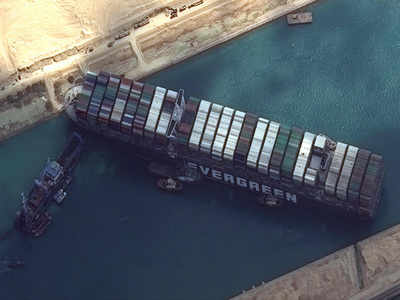
Maps The Suez Canal map shows the space view of the Suez Canal Blockage. Image by Airbus Space via https://twitter.com/AirbusSpace/status/1375078054884749318/photo/1
The 120 miles artificial waterway, Suez Canal, connecting the Mediterranean Sea and the Red Sea has been experiencing a bad ‘traffic jam’. It took one gigantic ship a single day and bad weather to cause the world’s most used shipping lanes to get congested.
Since 23rd March 2021, a Japanese-owned golden-class container ship Ever Given, currently under the operation of a Taiwanese company, is wedged in Egypt’s Suez Canal. One of the largest Suez Canal ship and among the largest ships at sea is stuck in a position that an industry expert compared to an “enormous beached whale”. With ripples felt across world trade, signs of global economic toll surface.
Here are some basics on what is the Suez Canal, how is the Suez Canal blocked, and the impact on global trade.

WHAT IS THE SUEZ CANAL?
After 10 years and the efforts of about 1.5 million labourers, an artificial sea-level waterway opened on 17 November 1869. What looks like a thin strip of water via satellite imagery is what is dividing Africa and Asia. Suez Canal enables a direct shipping route between Europe and Asia, without having to navigate through the African continent. Needless to say, its vital role in international trade has made it a center of conflict since its opening in 1869.
The canal has a rich history attached to it, since the inception of its idea, its construction, inauguration, the Suez Canal Crisis, Arab–Israeli wars of 1967 and 1973, there is a lot to explore. But in a more direct sense, its importance can be best understood by the fact that in 2020 alone, over 18,500 vessels crossed the canal!
TECHNICAL OR HUMAN ERROR?
SUEZ Canal news is now making the headlines for a sad reason. As a massive tailback of over 320 vessels wait to traverse the canal, the attempts to unclog the Suez Canal continue. But what caused the 200,000-tonne ship to aground in the 985 feet wide, narrow section of the canal?
The Ever Given is 193 feet wide and 1,312 feet long, making it the largest vessel in operation at the sea. It’s more than twice as large as the Statue of Unity! This is also the maximum length allowed by the Suez Canal.
During a sandstorm this week, high winds pushed the vessel sideways and 20,000 containers stacked on deck may have acted as a sail, forcing the vessel’s bow to aground on the eastern bank and its stern on the western. While the authorities left the possibility of “a technical error or a human error” open with an ongoing probe, as announced by Lt. Gen. Osama Rabie, head of Suez Canal Authority, they are under great pressure to remove the ship.
According to Bernhard Schulte Ship Management, responsible for managing the Ever Given’s crew and maintenance, has reported that two Suez-based pilots were on board to guide the ship through the canal during the incident. They have also accounted for all 25 crew members on board as safe.
UNCLOGGING THE SUEZ CANAL
As efforts to refloat the wedged container ship are complicated by unstable weather, the Suez Canal Authority reported that efforts to free the ship would resume once the dredging operation to remove 20,000 cubic metres of sand at its bow are completed.
Two additional tugboats are set to arrive at the clogged site on 28 March by the Dutch Rescue Team. It is in the wake of the failed attempt to dislodge the ship that took place on 26 March, with eight large tugboats dispatched at the site as reported by the Suez Canal Authority.
The Suez Canal Authority has welcomed help from the United States. Meanwhile, Turkey, amid the recent tension and many years of animosity, has agreed to send a vessel for help. A move likely to help repair the ties between the two nations.
The Taiwanese Company, Evergreen Marine, which operated the Suez Canal ship, has reportedly announced the deployment of two professional rescue teams from Japan and the Netherlands, as well as their attempts to create a “more effective plan” to refloat the vessel.
Experts have suggested the removal of containers on board the ship, to reduce the weight, tugboats, and dredging of sand, to free the vessel. It is also likely to take longer than expected. The problem is not likely to end with just removing Ever Given, the ‘traffic jam’ waiting to move ahead could take weeks to clear up as well.
Amid the Suez Canal blockage, the Government of India has outlined a 4-point plan, for the $200 Billion, import and export with North America, South American, and Europe. It includes the prioritization of cargo, delivery rates, re-routing ships, and advisory to ports.
IMPACT ON GLOBAL TRADE
The canal is responsible for 10%-12% of commercial shipping and about 2.5% of the world’s oil. Prolonged congestion is holding up about $9.6 billion worth of goods per day, according to sources. While the efforts to open the waterway are ongoing, it could take weeks. The vessels waiting for their turn to cross the Suez Canal are mostly consumer goods as well as oils. But the hold up at the canal is proving to be expensive for shippers as the delay continues. This leaves them with two choices: make a U-turn for the Cape of Good Hope or wait for the canal to open up.
It is not an easy decision, since the travel around the south tip of Africa adds about 28 days to the otherwise 13 days journey. This also means higher costs. The already billions that the world economy is losing continue to pile up as Ever Green remains wedged at the Suez Canal.
The already hindered supply chain due to COVID-19 had cost the global economy trillions of dollars, and while the full impact of this blockage in the world’s busiest waterway may not be visible immediately, it is more than likely to put a further strain, including oil price jumps, shipping prices to upsurge and a shoot up in global inflation.
Author Bio: Disha Walia is a writer, editor for those who have trouble putting thoughts into words, and a lifelong storyteller. As a Psychology graduate with a Master’s degree in English, she loves exploring the unknown world of words with an interdisciplinary approach. She has a love for hobbies that focus on finer details, creativity, and intriguing depths.


